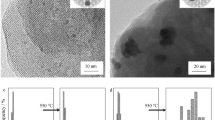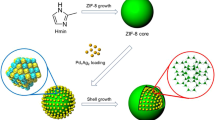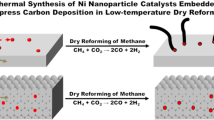Abstract
Sintering resistant noble metal nanoparticles are critical to the development of advanced catalysts with high activity and stability. Herein, we reported the construction of highly dispersed Pd nanoparticles loaded at the inner wall of ZrO2 hollow spheres (Pd@HS-ZrO2), which shows improved activity and thermal stability over references in the Pd-ZrO2 (catalyst-support) system. Even after 800 °C high temperature calcination, the Pd nanoparticles and ZrO2 hollow spheres did not undergo morphological changes. The Pd@HS-ZrO2 manifests batter catalytic activity and thermal stability than the counterpart Pd/ZrO2 catalysts. In comparison to Pd/ZrO2-800, Pd@ZrO2-800 exhibits a 25°C reduction in the temperature required for complete conversion of CO. The enhanced catalytic activity and thermal stability of Pd@HS-ZrO2 can be attributed to the nanoconfinement effect offered by the 10 nm wall thickness of the ZrO2 hollow spheres, which suppresses the coarsening of the Pd nanoparticles (active center for catalysis).
Similar content being viewed by others
References
Prieto G, Tüysüz H, Duyckaerts N, et al. Hollow nano- and microstructures as catalysts. Chemical Reviews, 2016, 116(22): 14056–14119
Alonso F, Beletskaya I P, Yus M. Metal-mediated reductive hydrodehalogenation of organic halides. Chemical Reviews, 2002, 102(11): 4009–4092
Zhang J, Bian D, Shao G, et al. Facile synthesis of sandwich-like MnO2@Pd@MnO2 hollow spheres with superior catalytic stability and activity. Journal of Alloys and Compounds, 2021, 870: 159415
Cheng N, Banis M N, Liu J, et al. Extremely stable platinum nanoparticles encapsulated in a zirconia nanocage by area-selective atomic layer deposition for the oxygen reduction reaction. Advanced Materials, 2015, 27(2): 277–281
Spezzati G, Su Y, Hofmann J P, et al. Atomically dispersed Pd-O species on CeO2 (1 1 1) as highly active sites for low-temperature CO oxidation. ACS Catalysis, 2017, 7(10): 6887–6891
Chen J, Wang D, Qi J, et al. Monodisperse hollow spheres with sandwich heterostructured shells as high-performance catalysts via an extended SiO2 template method. Small, 2015, 11(4): 420–425
Kumar A, Ramani V. Strong metal–support interactions enhance the activity and durability of platinum supported on tantalum-modified titanium dioxide electrocatalysts. ACS Catalysis, 2014, 4(5): 1516–1525
Tauster S. Strong metal–support interactions. Accounts of Chemical Research, 1987, 20(11): 389–394
Zhang J, Zhu D, Yan J, et al. Strong metal–support interactions induced by an ultrafast laser. Nature Communications, 2021, 12(1): 6665
Luo Z, Zhao G, Pan H, et al. Strong metal–support interaction in heterogeneous catalysts. Advanced Energy Materials, 2022, 12(37): 2201395
Tang M, Li S, Chen S, et al. Facet-dependent oxidative strong metal–support interactions of palladium–TiO2 determined by in situ transmission electron microscopy. Angewandte Chemie International Edition, 2021, 60(41): 22339–22344
Liu S, Xu W, Niu Y, et al. Ultrastable Au nanoparticles on titania through an encapsulation strategy under oxidative atmosphere. Nature Communications, 2019, 10(1): 5790
Oschatz M, Lamme W S, **e J, et al. Ordered mesoporous materials as supports for stable iron catalysts in the Fischer–Tropsch synthesis of lower olefins. ChemCatChem, 2016, 8(17): 2846–2852
Song S, Liu X, Li J, et al. Confining the nucleation of Pt to in situ form (Pt-enriched cage)@CeO2 core@shell nanostructure as excellent catalysts for hydrogenation reactions. Advanced Materials, 2017, 29(28): 1700495
Chen Y, Ji S, Wang Y, et al. Isolated single iron atoms anchored on N-doped porous carbon as an efficient electrocatalyst for the oxygen reduction reaction. Angewandte Chemie International Edition, 2017, 56(24): 6937–6941
Yue L, Li J, Chen C, et al. Thermal-stable Pd@mesoporous silica core–shell nanocatalysts for dry reforming of methane with good coke-resistant performance. Fuel, 2018, 218: 335–341
Tian Y, Duan H, Zhang B, et al. Template guiding for the encapsulation of uniformly subnanometric platinum clusters in beta-zeolites enabling high catalytic activity and stability. Angewandte Chemie International Edition, 2021, 60(40): 21713–21717
Yang F, Wu C, Yu H, et al. The fabrication of hollow ZrO2 nanoreactors encapsulating Au-Fe2O3 dumbbell nanoparticles for CO oxidation. Nanoscale, 2021, 13(14): 6856–6862
Bi F, Zhao Z, Yang Y, et al. Chlorine-coordinated Pd single atom enhanced the chlorine resistance for volatile organic compound degradation: mechanism study. Environmental Science & Technology, 2022, 56(23): 17321–17330
Zhang X, Bi F, Zhao Z, et al. Boosting toluene oxidation by the regulation of Pd species on UiO-66: synergistic effect of Pd species. Journal of Catalysis, 2022, 413: 59–75
Bi F, Zhao Z, Yang Y, et al. Efficient degradation of toluene over ultra-low Pd supported on UiO-66 and its functional materials: reaction mechanism, water-resistance, and influence of SO2. Environmental Functional Materials, 2022, 1(2): 166–181
Xu H, Zhang Z, Liu J, et al. Entropy-stabilized single-atom Pd catalysts via high-entropy fluorite oxide supports. Nature Communications, 2020, 11(1): 3908
Sun X, Li Y. Colloidal carbon spheres and their core/shell structures with noble-metal nanoparticles. Angewandte Chemie International Edition, 2004, 43(5): 597–601
Chen S, Fu S, Lang Y, et al. Submicronic spherical inclusion black pigment by double-shell reaction sintering. Journal of the American Ceramic Society, 2020, 103(3): 1520–1526
Hong E, Kim C, Lim D H, et al. Catalytic methane combustion over Pd/ZrO2 catalysts: effects of crystalline structure and textural properties. Applied Catalysis B: Environmental, 2018, 232: 544–552
Wu Y, Chen J, Hu W, et al. Phase transformation and oxygen vacancies in Pd/ZrO2 for complete methane oxidation under lean conditions. Journal of Catalysis, 2019, 377: 565–576
Wang Y, Zhang C, He H. Insight into the role of Pd state on Pd-based catalysts in o-xylene oxidation at low temperature. ChemCatChem, 2018, 10(5): 998–1004
Li P, He C, Cheng J, et al. Catalytic oxidation of toluene over Pd/Co3AlO catalysts derived from hydrotalcite-like compounds: effects of preparation methods. Applied Catalysis B: Environmental, 2011, 101(3–4): 570–579
Park J H, Cho J H, Kim Y J, et al. Hydrothermal stability of Pd/ZrO2 catalysts for high temperature methane combustion. Applied Catalysis B: Environmental, 2014, 160–161: 135–143
Patil K N, Prasad D, Bhanushali J T, et al. Chemoselective hydrogenation of cinnamaldehyde over a tailored oxygen-vacancy-rich Pd@ZrO2 catalyst. New Journal of Chemistry, 2021, 45(12): 5659–5681
Vedyagin A A, Volodin A M, Kenzhin R M, et al. CO oxidation over Pd/ZrO2 catalysts: role of support’s donor sites. Molecules, 2016, 21(10): 1289
Zhao S, Yang Y, Bi F, et al. Oxygen vacancies in the catalyst: efficient degradation of gaseous pollutants. Chemical Engineering Journal, 2023, 454(3): 140376
Rao R, Ma S, Gao B, et al. Recent advances of metal-organic framework-based and derivative materials in the heterogeneous catalytic removal of volatile organic compounds. Journal of Colloid and Interface Science, 2023, 636: 55–72
Zhang X, Li H, Lv X, et al. Facile synthesis of highly efficient amorphous Mn-MIL-100 catalysts: formation mechanism and structure changes during application in CO oxidation. Chemistry, 2018, 24(35): 8822–8832
Zhang X, Hou F, Yang Y, et al. A facile synthesis for cauliflower like CeO2 catalysts from Ce-BTC precursor and their catalytic performance for CO oxidation. Applied Surface Science, 2017, 423: 771–779
Suchorski Y, Kozlov S M, Bespalov I, et al. The role of metal/oxide interfaces for long-range metal particle activation during CO oxidation. Nature Materials, 2018, 17(6): 519–522
** L Y, Ma R H, Lin J J, et al. Bifunctional Pd/Cr2O3–ZrO2 catalyst for the oxidation of volatile organic compounds. Industrial & Engineering Chemistry Research, 2011, 50(18): 10878–10882
Zhang Z, Zhang L, Hülsey M J, et al. Zirconia phase effect in Pd/ZrO2 catalyzed CO2 hydrogenation into formate. Molecular Catalysis, 2019, 475: 110461
Yang X, Ma X, Yu X, et al. Exploration of strong metal–support interaction in zirconia supported catalysts for toluene oxidation. Applied Catalysis B: Environmental, 2020, 263: 118355
Bi F, Zhang X, **ang S, et al. Effect of Pd loading on ZrO2 support resulting from pyrolysis of UiO-66: application to CO oxidation. Journal of Colloid and Interface Science, 2020, 573: 11–20
Acknowledgements
The authors would like to thank the financial support from the National Natural Science Foundation of China (Grant Nos. 52173257, 52162028, and 51962015) and the Jiangxi Double Thousand Plan (Grant No. jxsq2018102141).
Author information
Authors and Affiliations
Corresponding authors
Electronic Supplementary Material
11706_2023_649_MOESM1_ESM.pdf
Enhanced catalytic activity and thermal stability by highly dispersed Pd-based nanocatalysts embedded in ZrO2 hollow spheres
Rights and permissions
About this article
Cite this article
Liu, T., Zhang, J., Xu, M. et al. Enhanced catalytic activity and thermal stability by highly dispersed Pd-based nanocatalysts embedded in ZrO2 hollow spheres. Front. Mater. Sci. 17, 230649 (2023). https://doi.org/10.1007/s11706-023-0649-5
Received:
Accepted:
Published:
DOI: https://doi.org/10.1007/s11706-023-0649-5




